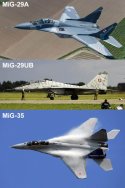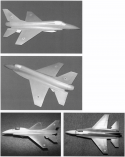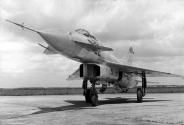Has anyone ever found an honest assessment of the LCA/Tejas program? 90% of what you read is flag-waving nonsense, the other 10% is surface-level speculation (corruption, changing goal posts, Kaveri failure, etc.)
I'll give you one.
The LCA program started in 1984. Design was finalised in 1990. First flight was in 2001. 5 years from decision to design, 10 years from design to flying prototype. If all the other elements were in place it would be ready for production within 5 more years.
Compare with Gripen - program starts in 1980, contract in 1983, prototype in 1987, first flight in 1988 (due to indigenous FBW issues), first serial production in 1994. And Sweden already had experience with modern fighters.
Tejas meant to be developed and produced domestically so importing components was contrary to the aim of the program and
India wasn't in a hurry.
Here's something that most people miss about Tejas -
the aircraft that IAF bought in the 1980s:
- 40 MiG-23MF from 1982
- 40 Mirage 2000T from 1985
- 40 MiG-29 from 1987
- replacement MiG-21s (built by HAL, total number built is over 800 since 1964)
- 160 Jaguars from 1979 (120 built by HAL)
- 95 MiG-23BN from 1981
- 210 MiG-27 from 1985 (built by HAL)
All of those aircraft had planned service life of 25 years which means that their
planned retirement - not including likely life extensions - would
begin in 2005-2010.
Tejas was supposed to be their replacement after 2005-2010 which fits on a timescale with the first flight in 2001.
So the question is: if everything went according to plan
where did it all go wrong?
The answer is:
in Russia.
With no domestic orders Russian defense industry was faced with starvation so around 1995 Russians approached India with an offer to develop the Su-30MKI. Russia agreed for HAL to manufacture it locally, with the exception of radar and engines, as well as agreed for extensive modifications with the use of third party solutions - Israeli and French - which meant that Su-30MKI was legally a joint project. Contract for first 50 aircraft was signed
in 1996.
Note: Tejas FBW program was only started in 1992.
That offer wasn't something that India imagined when planning Tejas because USSR would not share its best fighter with India. Soviet Union offered India its weapons on good conditions but they weren't best systems available. The leasing of an obsolete (first boat in class) Charlie SSGN (Chakra) was a complicated matter.
But Su-30MKI was
the best system available in Russia.
What's more important
China already bought Su-27 which means that India would have to match them. They would either buy Su-27s or more expensive western equivalents. It shouldn't surprise anyone that when given the opportunity they
changed priorities at the expense of Tejas.
Su-30MKI was a product of 1995-2004 which is when 100 of 272 planes were built. F-22A was only entering serivce. It meant that
India had a heavy multirole fighter more capable then any in Russian air force and comparable to American F-15E.
This is why USAF sent F-15s to test the MKI around 2007-08.
Su-30MKI proved to be so successful that it convinced Kremlin to finance the development of Su-30SM with domestic solutions - which means that India developed the Su-30SM for Russia and a significant part of funding for other systems used in Sukhoi's planes were funded or co-funded by India. Irbis-E was developed from Bars, and Bars was developed with Indian funds.
Su-30MKI was a success story and if it wasn't for the fact that Russia didn't have good radar technology it would still be considered a very capable aircraft. Russian radars are the problem. AN/APG-63 could be upgraded to (v)3 standard with AESA antenna but Bars (slotted/planar)
can't be upgraded to Irbis-E (PESA) and Byelka (AESA) has completely different system architecture.
But it isn't even particularly a problem of Russian radar technology as it is the fact that
China managed to skip a generation with their own radars as well as aerial and electronic warfare doctrines. Because of that the two threats that India faces - China and Pakistan - suddenly shifted their potential.
Tejas is a problem not because there's something particularly wrong with Tejas, but because the
solution that India developed to China/Pakistan problem in the 90/00s suddenly and unexpectedly became obsolete some 10 or 20 years too early. That solution required Tejas to take a back seat in terms of priority or funding but it would be fine, until China "cheated" and started building J-20s, J-16s and putting AESA radars everywhere when it wasn't supposed to.
Look at Japan or Korea: apart from F-35s their air forces are nowhere near as capable and the modernization will take time. Look at European NATO - apart from the few countries who got F-35s first most are flying 90/00s designs. Eurofighter and Rafale only now get AESA arrays because nobody funded it. Even the US is forced to speed up development because of China's progress in the field.
But for India it gets worse because the solution to any future threat
was considered and because of how successful the Su-30MKI India chose to develop another joint project - FGFA based on Russian PAK-FA.
If you ignore the technical problems and just evaluate the decision on a political and economic level (which is how defense procurement is decided!) there was nothing indicating that it was a bad idea. When you look at the extent of Russian-Indian cooperation in the 90/00 it was a streak of massive wins for India and everyone expected that trend to continue.
But...
First to gain monopolistic position over Mikoyan Sukhoi lied that they have the PAK-FA design solved when they didn't.
Then when energy prices rose in the 2000s due to American wars Kremlin decided to play
supapowah and shifted resources to rapid modernization (State Armaments Program 2010-2020) and retaining of size, rather than capability of armed forces.
Then in 2014 even more funding had to be redirected away from R&D to improving readiness and modernization of active forces and sanctions took 50% of exchange rate.
And then in 2017 came CATSAA and India split from FGFA because it no longer was practical to stay involved.
The original plan was good. India would have Su-30MKI and Su-57 clones and wouldn't worry about Tejas so much. But Russia didn't do their part and India has to quickly catch up with 20 years of delay. Nothing that is happening around Tejas is out of ordinary. EF2000, Gripen, Rafale - they all had similar issues, except those countries could afford to reduce buys and delay capabilities while for India whatever they do with Tejas is too little too late.
And because of that every year that Tejas is delayed the opportunity to sell something to plug the hole becomes very profitable. So the narrative in the media doesn't reflect what the technological reality is but what each side wants it to be to make their sale of product.
-------
As for the "missed opportunity" of
licensing MiG-29...
MiG-29 was designed for Soviet doctrine in Europe. It was a short range
frontal fighter (which is a Soviet doctrinal role) with good speed and climb and maneuverability to beat NATO fighters in WVR one-on-one. And indeed when it entered service it was a very capable plane with many advantages over its opponents. But it was a flying Strv103 - unique design optimized for technology at the time which was made instantly obsolete by introduction of stabilizers and composite armor.
MiG-29 was made instantly obsolete by active homing missiles and better radar technology and every optimization for WVR became a burden.
For USSR it wasn't a problem because MiG-29 flew in 1977 and entered service in 1983 with planned service life of 25 years so
replacements would start around 2005.
But India was buying MiG-29 in 1987 and service life would definitely be longer than 25 years and they would be the only ones funding the development of a better radar, avionics and weapons.
Russian electronics was behind western which is why Su-27 radar - which could have better parameters due to size of array - often decided the sale.
MiG-29 was too small for Russian radar technology
Here:

Why buy and obsolete and inefficient airframe to install western systems? The very point of Tejas was to have a modern and efficient airframe.
One of the reason why Romania modernized its MiG-21s instead of MiG-29s in the 90/00s was because there was not much difference in performance and economies of scale favored LanceR. With good ground control or AEW a MiG-21 with helmet cueing and modern combat system is not much worse. So why would India buy MiG-29 when they had Bisons?
Poland uses MiG-29 and F-16 and tested Mirage and Gripen in 1998-2002. Here's what the pilots say about the Fulcrum vs the others:
- lack of ARH missiles disqualifies it in modern BVR combat (duh)
- weak and primitive radar greatly reduces situational awareness
- IRST is limited to R-73 range so it doesn't help
- no ground attack capability
- lack of FBW and outdated control systems make flying it a chore mentally and physically.
- Luftwaffe pilots were impressed after 1991 because they could only compare it to F-4
Also if you want the tactical benefits of a two-seater aircraft you can forget about MiG-29. It's airframe is optimized for single-seater performance and the UB handles poorly and is very cramped and inefficient and also pay attention to the nose. Where is the radar?

Also there's no aerial refueling. Which is why MiG-35 had to be completely redesigned compared to MiG-29 and MiG-29K/M... to offer 1999 quality
in 2019.




